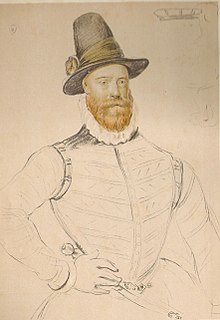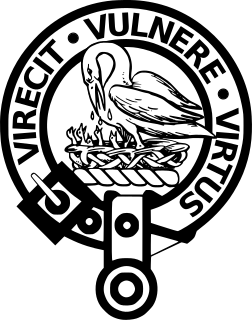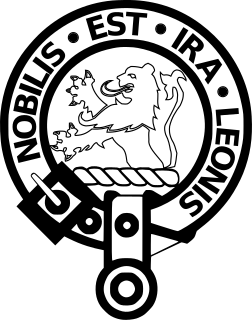| Clan Makgill | |
|---|---|
 | |
| Motto | Sine Fine (Without end) [1] |
| Profile | |
| Region | Lowland |
| Chief | |
 | |
| Ian Arthur Alexander Makgill [1] | |
| 14th Viscount of Oxfuird [1] | |
Clan Makgill is a Lowland Scottish clan. [2]
| Clan Makgill | |
|---|---|
 | |
| Motto | Sine Fine (Without end) [1] |
| Profile | |
| Region | Lowland |
| Chief | |
 | |
| Ian Arthur Alexander Makgill [1] | |
| 14th Viscount of Oxfuird [1] | |
Clan Makgill is a Lowland Scottish clan. [2]
The historian George Fraser Black suggested in his work Surnames of Scotland that the surname Makgill is derived from Mac an ghoill which means son of the lowlander or son of the stranger. [2] The name was established in Galloway before the thirteenth century. [2] In 1231 Maurice Macgeil witnessed a charter of Maldouen, Earl of Lennox to the church of St Thomas the Martyr of Arbroath. [2]
During the reign of James V of Scotland, James Makgill, a descendant of the Galloway family was a prominent Edinburgh merchant and later became Provost of Edinburgh. [2] He supported the reformed religion and the eldest of his two sons, Sir James Makgill, purchased the estate of Nether Rankeillour in Fife. [2] James studied law at Edinburgh and was recognised as an able scholar. [2] He became a member of the College of Justice in June 1554, and in August of the same year he became a Lord of Session. [2] James Makgill bought the estate of Nether Rankeillour and took the judicial title "Lord Rankeillor". He became a friend and supporter of the religious reformer, John Knox. [2] In 1561 when Mary, Queen of Scots returned to Scotland from widowhood in France, Makgill became one of her Privy Councillors. [2] However he was also heavily implicated in the murder of the queen's secretary David Rizzio and as a result was deprived of his judicial rank and was forced to flee from Edinburgh. [2] He was later pardoned but was ordered to stay north of the River Tay. [2] In December 1567, through the influence of the Regent Moray, Makgill was restored to his offices. [2] He later attended as one of the regent's commissioners who attended the regent on his journey to York to present accusations of the queen who was then in exile. [2] He was also later an ambassador to the court of Elizabeth I of England in 1571 and 1572, however while he was absent his house in Edinburgh was attacked by supporters of Queen Mary and his wife was killed. [2] He died in 1579 and was succeeded by his younger brother who held the lands of Cranston-Riddell and who had been appointed to the Court of Session in 1582. [2] He took the title "Lord Cranston-Riddell" and was succeeded in 1594 by his son, David, who followed him onto the Bench. [2]
He was succeeded by yet another David, the third Laird of Cranston-Riddell, who died in 1619 without male issue. [2] His brother was James Makgill who in 1627 was created a Baronet of Nova Scotia. [2] He was appointed a Lord of Session in 1629 and in 1651 was elevated to the peerage as Viscount of Oxfuird. [2] He died in 1663 and was succeeded by his son, Robert Makgill, second Viscount Oxfuird. [2]
Robert Makgill, second Viscount Oxfuird had a son named Thomas who died in 1701, five years before his father, Robert and left no issue. [2] William Maitland son of Christian Makgill, daughter of the second viscount then claimed the viscountcy but this was challenged in 1734 by James Makgill of Nether-Rankeillor who was sixth in descent from Lord Rankeillor. [2] The House of Lords refused to accept the claim of either James Makgill or Christian Makgill's son, William Maitland. [2] As a result, the title became dormant although Christian's younger sister, Henrietta, later assumed the title of Viscountess of Oxfuird but without establishing the legal right to the title and she died in 1758 without issue. [2]
The Nether-Rankeillor estates later passed through an heiress to Frederick Maitland, sixth son of the Earl of Lauderdale. [2] The family then assumed the surname Maitland Makgill. [2] Later David Maitland Makgill became heir to the Crichton viscountcy of Frendraught and styled himself Maitland Makgill Crichton. [2] It was a member of this family who established the right to the chiefship of the Clan Crichton in 1980 and abandoned his additional surnames as required by the Lord Lyon King of Arms. [2] In 1986 his kinsman, George Hubbard Makgill was recognised as the thirteenth Viscount of Oxfuird and chief of Clan Makgill. [2]
The current Chief of Clan Makgill is Ian Arthur Alexander Makgill, 14th Viscount of Oxfuird. [1]

The Battle of Langside was fought on 13 May 1568 between forces loyal to Mary, Queen of Scots, and forces acting in the name of her infant son James VI. Mary’s short period of personal rule ended in 1567 in recrimination, intrigue, and disaster when, after her capture at Carberry Hill, she was forced to abdicate in favour of James VI, her infant son. Mary was imprisoned in Loch Leven Castle, while her Protestant half-brother, James Stewart, Earl of Moray, was appointed Regent on behalf of his nephew. In early May 1568 Mary escaped, heading west to the country of the Hamiltons, high among her remaining supporters, and the safety of Dumbarton Castle with the determination to restore her rights as queen. Mary was defeated and went into exile and captivity in England. The battle can be regarded as the start of the Marian civil war.

James Douglas,4th Earl of Morton was the last of the four regents of Scotland during the minority of King James VI. He was in some ways the most successful of the four, since he won the civil war that had been dragging on with the supporters of the exiled Mary, Queen of Scots. However, he came to an unfortunate end, executed by means of the Maiden, a predecessor of the guillotine.

Marquess of the County of Bute, shortened in general usage to Marquess of Bute, is a title in the Peerage of Great Britain. It was created in 1796 for John Stuart, 4th Earl of Bute.

Earl of Stair is a title in the Peerage of Scotland. It was created in 1703 for the lawyer and statesman John Dalrymple, 2nd Viscount of Stair.

Viscount of Oxfuird is a title in the Peerage of Scotland. It was created in 1651 for Sir James Makgill, 1st Baronet, along with the subsidiary title of Lord Makgill of Cousland, also in the Peerage of Scotland, with remainder to his "heirs male of tailzie and provision whomsoever". He had already been created a Baronet, of Makgill, in the Baronetage of Nova Scotia on 19 July 1625, with remainder to heirs male whatsoever. The remainder to heirs male whatsoever was a Scottish concept that permitted inheritance by persons not descended from the original grantee, but descended in the male line from male-line ancestors of the grantee. However, on the death of the first Viscount's son, the second Viscount, the Lordship and Viscountcy were assumed by his daughter Christian, as heir of tailzie and provision. Her son Robert Maitland Makgill also voted as Viscount of Oxfuird at the election of Scottish Representative Peers in 1733.

Earl Jellicoe is a title in the Peerage of the United Kingdom. It was created, along with the subsidiary title Viscount Brocas, of Southampton in the County of Southampton, on 29 June 1925 for Admiral of the Fleet John Jellicoe, 1st Viscount Jellicoe, on his return from being Governor-General of New Zealand, with remainder to the heirs male of his body. He had already been created Viscount Jellicoe, of Scapa in the County of Orkney, on 15 January 1918, created with remainder to the heirs male of his body, and in default of such issue to his eldest daughter and the heirs male of her body, with the like remainder in default of such issue to every other daughter successively in order of priority of birth, and to the heirs male of their bodies. The Jellicoe viscountcy was created with remainder to his daughters and their heirs male because, at the time of the creation, Jellicoe had five daughters and no sons. His only son was born three months later.

The Lord Lieutenant of Renfrewshire is the representative of the British Crown covering a lieutenancy area of the county of Renfrewshire in the west central Lowlands of Scotland.

Clan Murray is a Highland Scottish clan. The chief of the Clan Murray holds the title of Duke of Atholl. Their ancestors who established the family in Scotland in the 12th century were the Morays of Bothwell. In the 16th century descendants of the Morays of Bothwell, the Murrays of Tullibardine, secured the chiefship of the clan and were created Earls of Tullibardine in 1606. The first Earl of Tullibardine married the heiress to the Stewart earldom of Atholl and Atholl therefore became a Murray earldom in 1626. The Murray Earl of Atholl was created Marquess of Atholl in 1676 and in 1703 it became a dukedom. The marquess of Tullibardine title has continued as a subsidiary title, being bestowed on elder sons of the chief until they succeed him as Duke of Atholl.
George Hubbard Makgill, 13th Viscount of Oxfuird,, was a Scottish peer and Chief of the Makgill family. He inherited his titles from his uncle.

Clan Crichton is a Lowland Scottish clan.

Clan Stewart is a Scottish Highland and Lowland clan. The clan is recognised by Court of the Lord Lyon; however, it does not have a Clan Chief recognised by the Lord Lyon King of Arms. Because the clan has no chief it can be considered an armigerous clan; however, the Earls of Galloway are now considered to be the principal branch of this clan, and the crest and motto of The Earls of Galloway's arms are used in the Clan Stewart crest badge. The Court of the Lord Lyon recognises two other Stewart/Stuart clans, Clan Stuart of Bute and Clan Stewart of Appin. Clan Stuart of Bute is the only one of the three clans at present which has a recognised chief.
William Crichton, 1st Lord Crichton was an important political figure in the late medieval Kingdom of Scotland.

Sir George Makgill, 11th Baronet, de jure 11th Viscount of Oxfuird was a Scottish baronet who was also a novelist and right-wing propagandist.

Frederick Lewis Maitland was a distinguished officer of the Royal Navy.

Clan Stuart of Bute is a Highland Scottish Clan and is a branch of the larger Clan Stewart.
Margaret Stewart was the younger daughter of James II of Scotland and Mary of Guelders. Once engaged to the Lancastrian Prince of Wales, Margaret instead became the mistress of William Crichton, 3rd Lord Crichton, and the mother of his illegitimate daughter, Margaret Crichton, later Countess of Rothes, and possibly his son, Sir James Crichton, progenitor of the Viscounts of Frendraught. Margaret and Lord Crichton may have been married later, after the death of Crichton's wife.
Sir James MacGill, Lord Rankeillor of Nether Rankeillour. was a Scottish courtier and Senator of the College of Justice.

The Marian civil war in Scotland (1568–1573) was a period of conflict which followed the abdication of Mary, Queen of Scots, and her escape from Lochleven Castle in May 1568. Those who ruled in the name of her infant son James VI fought against the supporters of the Queen, who was exiled in England. Edinburgh Castle, which was garrisoned in her name, became the focus of the conflict and surrendered only after an English intervention in May 1573. The conflict in 1570 was called an "intestine war in the bowels of this commonwealth", and the period was called soon after an "intestine war driven by questions against authority."
David MacGill, McGill or Makgill, Lord Cranston Riddell (1532–1595) was a 16th-century Scottish judge and Senator of the College of Justice and Lord Advocate of Scotland from 1582 to 1595.
Sir William Binning of Wallyford (1637–1711) was a 17th-century Scottish landowner who served as Lord Provost of Edinburgh from 1675 to 1677.